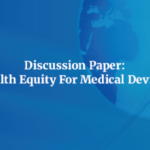Merely treating the disease is no longer the goal of the global healthcare system. The entire industry has rearranged itself around the centerpiece called “patients” over the last few years. This shift has also created a value-driven care delivery system rather than just an outcome-driven one. For example, 90% of healthcare spending in the US is directed toward patients with chronic conditions and improving their livelihoods.
The value-based care model with such a substantial monetary budget necessitates on-time and correct risk stratification. By proactively understanding different health conditions, their likely prognoses, and the subsequent treatment or care plans, healthcare stakeholders can intervene earlier and prevent complications, ultimately reducing costs per capita and improving patient outcomes. This is why many new and incumbent care providers and payers are reinventing healthcare delivery, and it is no surprise that many of them are looking at technology as the critical enabler of this new paradigm. Cutting-edge technology like AI and machine learning (ML) can radically transform healthcare delivery by allowing providers to understand individual patient needs and develop tailored intervention plans. It can improve health outcomes, improve resource management, and reduce costs.
Traditional vs. GenAI-powered risk stratification
Traditionally, healthcare providers assess risk based on factors like age, family history, and lifestyle habits. While valuable, this approach can be broad, potentially missing individuals at high risk or over-treating those at lower risk. Risk stratification takes this a step further by categorizing patients based on their likelihood of developing a specific disease. A research paper released in the Journal of the American Medical Association (JAMA) Internal Medicine (doi:10.1001/jama.293.5.572) found that implementing risk stratification for heart failure patients led to a 12% reduction in unnecessary hospital admissions. This demonstrates the potential for risk stratification to improve resource allocation and patient outcomes.
GenAI is a new breed of artificial intelligence (AI) that goes beyond traditional methods. It incorporates a deeper understanding of human biology and genomics, the study of genes, and their role in health and disease. This allows GenAI to analyze a vast amount of data, including:
- Healthcare utilization and medical history: This reveals patterns in a patient’s medical journey, potentially highlighting risk factors.
- Genetic predispositions: GenAI can identify genes that increase susceptibility to certain diseases. A 2021 study in Nature Medicine showed that AI models could identify individuals at high risk for Alzheimer’s disease with up to 70% accuracy based on genetic data alone.
- Individual responses to treatments: Understanding how a patient reacts to medications can inform future treatment decisions. A 2022 study in JAMA Internal Medicine showed that healthcare providers using AI for risk stratification reported a 30% increase in their confidence when making clinical decisions about medication selection.
- Social determinants of health: Different aspects like education, income, and access to nutrition can directly impact health outcomes. Centers for Disease Control and Prevention’s (CDCs) report from last year highlighted that social determinants account for up to 80% of health disparities across populations. GenAI can incorporate these factors to create a more holistic picture of a patient’s risk.
By analyzing this comprehensive data set, GenAI creates a more nuanced picture of a patient’s overall health risk. This empowers healthcare providers to:
- Identify high-risk patients earlier: Early detection is crucial for effective treatment and improved outcomes. A 2023 study published in the Lancet Oncology demonstrated that AI-powered risk stratification models can identify high-risk, potential cancer patients up to four years before traditional methods.
- Develop personalized treatment plans: By considering an individual’s unique genetic makeup and response history, GenAI can guide the development of tailored treatment strategies.
- Optimize resource allocation: Healthcare resources are finite. GenAI helps ensure that patients with the greatest need receive the most appropriate level of care. A 2023 report by McKinsey & Company estimated that AI-driven risk stratification could lead to a 15% reduction in healthcare costs by optimizing staffing and resource allocation.
GenAI is a powerful tool, but it’s important to remember it’s not a replacement for doctors. The ideal scenario involves a collaborative approach, where GenAI provides valuable insights that healthcare providers can leverage to personalize care plans. Doctors can use their clinical expertise and understanding of patients’ individual circumstances to interpret the data and make informed decisions. Incorporating GenAI into risk stratification significantly improves the process. GenAI builds upon the capabilities of traditional AI and ML by incorporating a deeper understanding of human biology and genomics. This allows GenAI to analyze healthcare utilization and medical history, genetic predispositions, and individual responses to treatments. GenAI, with NLP and OCR capabilities, can analyze vast amounts of data, including claims data, EHR information, and even social determinants of health, and combine that with genetic data to create a more comprehensive picture of a patient’s risk profile. Moreover, the GenAI algorithms can also identify high-risk patients much faster and with greater accuracy, potentially uncovering hidden patterns in the data that traditional methods might miss. This would enable healthcare providers to improve risk stratification, guide patient interventions, and help care teams make the best data-driven decisions. For instance, advanced risk stratification can help allot junior and senior care providers, depending on severity and medical needs. It would ensure the proper care delivery by the right clinical team members to suitable patients at the right time and in the right place, and it would usher us into a true era of patient-centric care delivery.
| A clinical comparison of traditional vs. AI- and ML-powered risk stratification | ||||
| Correct triage | Over triage | Under triage | Net accuracy | |
| AI and ML | 522 | 106 | 71 | 75.7% |
| Manual process | 436 | 145 | 144 | 59.8% |
Source: https://doi.org/10.1016/j.jen.2020.11.001
GenAI-based risk stratification for holistic healthcare
Beyond immediate care delivery, GenAI and ML-based risk stratification can also augment and improve other healthcare functions. Both payers and care providers can leverage GenAI and ML to enhance and streamline processes like outreach programs, long-term personalized treatment plans, and more.
- Data-backed outreach programs: Many healthcare professionals use risk stratification to determine meaningful patient engagement strategies. While this has been a practice for a long time, leveraging GenAI can make the process more accurate and faster. For instance, a patient might suffer a cardiac arrest, which puts them in a high-risk category. A targeted outreach program detailing the benefits of lifestyle changes after a heart attack can lead to better outcomes for such patients if identified early. Besides, GenAI learns in real-time and can factor in any sudden changes to a patient’s health parameters. This will help ease the workload on care providers. Returning to the previous example, once the patient starts living a healthy lifestyle and quitting smoking, real-time risk stratification can move them down into a low- or rising-risk category. Healthcare providers can thus reduce healthcare costs by prioritizing their high-risk patients and mitigating unnecessary or inappropriate healthcare utilization. By bestowing care providers with such abilities, GenAI will ultimately pave the way for organization-wide lean patient engagement efforts.
- Informed and personalized treatment plans: Healthcare providers can use AI-enabled risk stratification to create tailored treatment programs. A healthy patient with zero or minimum past health issues wouldn’t require extensive treatment plans. A simple care plan for them may include annual check-ups and a roster of providers available at preferred touchpoints during emergencies. But the treatment plan for, say, a diabetic patient would look vastly different. They will require strong patient-provider communication, regular check-ups, and medication management. GenAI, trained on big healthcare data, can instantaneously develop tailored care plans that account for the patient’s risk factors. With GenAI, patients become active participants in their own healthcare journey. By understanding their individual risk profile, they can make informed decisions about health and work collaboratively with doctors to develop a personalized care plan.
- Serve as care team assistant: Healthcare professionals can employ Gen AI as an invaluable care team assistant in risk stratification. For example, Gen AI can monitor a patient’s health and offer proactive, data-driven support with real-time insights. Gen AI can even flag any significant changes that may indicate a shift in risk level. In fact, its advanced learning capabilities can help assess vast amounts of data to identify health or disease patterns and predict potential health risks, allowing care teams to prioritize and personalize treatments more effectively. With GenAI, communication, coordination, and collaboration become much more seamless, as it can update all team members with the latest patient information and recommendations. This fosters a cohesive care environment, ultimately enhancing patient outcomes and optimizing resource utilization.
Setting new standards for data-driven care delivery
The effectiveness of population health management undeniably relies on accurately assessing ‘high-risk’ patients to negate poor and costly health outcomes that can otherwise be prevented. GenAI-powered risk stratification is ushering in a new era of personalized care. While there are certain hurdles, the potential benefits for the healthcare system as a whole are significant. Generative AI is set to revolutionize healthcare risk stratification by enhancing predictive accuracy, personalizing risk assessments, and enabling real-time monitoring through continuous data analysis. It can generate synthetic patient data to train models without compromising privacy, address data imbalances, and improve clinical decision support systems. By integrating with other technologies, such as wearable technology, and aiding in drug discovery, generative AI ensures timely interventions, better patient outcomes, and cost efficiency, paving the way for a more proactive and effective healthcare system.
As the GenAI technology evolves, we can expect even more sophisticated risk stratification models that can integrate wider data sources and provide even more granular insights into patient health. However, the onus would be on us to properly weigh different GenAI/ML models for health risk stratification before using them. Given the critical nature of this industry, there’s zero room for error. But together, we can build a healthier and safer future powered by GenAI-driven risk stratification.
- https://www.cdc.gov/chronic-disease/data-research/facts-stats/index.html#:~:text=Ninety%20percent%20of%20the%20nation%27s,significant%20health%20and%20economic%20benefits.
- https://www.thelancet.com/journals/lansea/article/PIIS2772-3682(24)00002-7/fulltext
- https://www.sciencedirect.com/science/article/pii/S0099176720303767
- https://www.techtarget.com/patientengagement/news/366584782/Using-Risk-Stratification-in-Patient-Engagement-Strategies
- https://www.ncbi.nlm.nih.gov/pmc/articles/PMC2980345/
- https://www.commonwealthfund.org/sites/default/files/documents/___media_files_publications_in_the_literature_2016_aug_1896_hibbard_improving_population_hlt_mgmt_hsr_08_23_2016_itl_v2.pdf
- https://www.sciencedirect.com/science/article/pii/S0099176720303767







